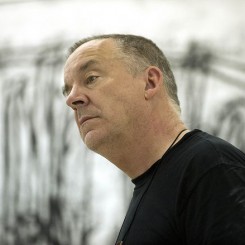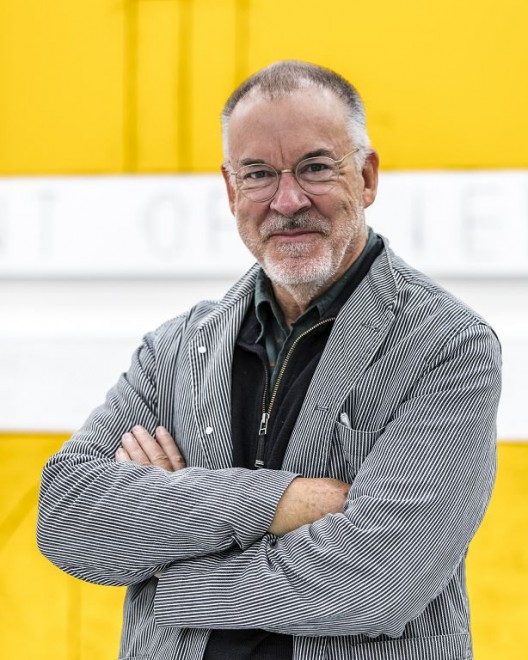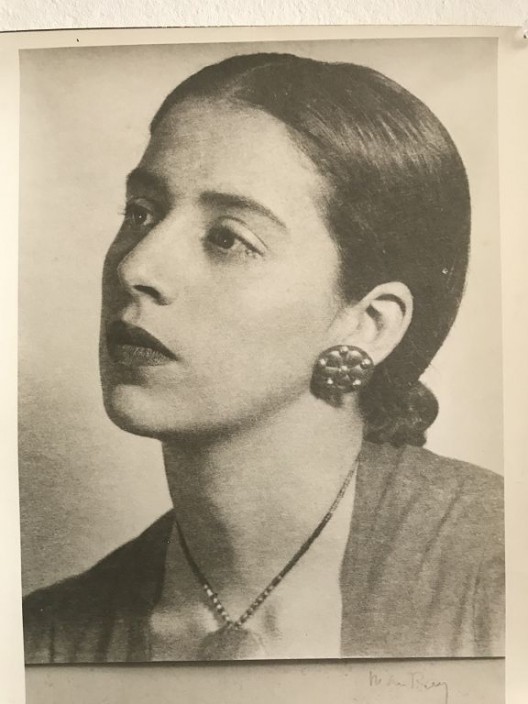Matt Mullican
The Feeling of Things
Pireelli HangarBicocca (Via Chiese 2, 20126, Milano) 12 Apr–16 Sept, 2018
curated by Roberta Tenconi
Representing That World
Galerie Mai 36 (Raemistrasse 37, Zurich) 3 Nov–23 Dec, 2017
Pictures Generation artist, Matt Mullican, renowned for his work with signs and flags and pioneering hypnosis performances, exhibited in China for the first time during West Bund Art & Design last November, with a special presentation of his flag works. He will have a major retrospective next year at HangarBicocca in Milan. Mullican has had solo shows at Stedelijk Museum, Amsterdam (1998); Museu de Arte Contemporânea de Serralves, Porto (2000); Museum of Modern Art, Oxford (2001); Ludwig Museum, Cologne (2005); Drawing Center, New York (2008); The Metropolitan Museum of Art, New York (2009); and Haus der Kunst, Munich (2011). His works have been presented at three editions of Documenta (1982, 1993, 1997); the Whitney Biennial and São Paulo Biennial (2008); Gwanju Biennale (2010); and Venice Biennale (2013).
On a chilly, grey day in Berlin, I met Matt Mullican at his studio in Schöneberg, not far from Potsdamer Strasse, in the back courtyard — the Hinterhof — of a typical old, semi-industrial building. The stairs up to the studio wrap-around a slow elevator that smells of grease and metal. Entering the studio, I see an assistant is arranging bright yellow works on canvas which cover the floor. Matt, just arrived from Los Angeles, sits behind his desk, absorbed in preparations for his upcoming show at Galerie Mai 36 in Zurich and the exhibitions of his flag works at FIAC in Paris and then West Bund in Shanghai. He apologizes for being jet-lagged but seems buoyant and energetic. He sits contentedly in a T-shirt. I shiver, nursing a nascent cold.
in Berlin? I mean: on a day like this! You come from Santa Monica, right?
Matt Mullican: Well, Santa Monica, then New York, and now Berlin.
CM: And on days like this you wish you were in Santa Monica, right? [Ed. I do]
MM: Not at all!
My mother’s still alive and she lives in Santa Monica. She’s an artist and an amazing person. She’s 97 years old. She had her first show 2 years ago, and sold it out and now, she’s a phenomenon. I’m not kidding! “Vogue” magazine, “The New Yorker” magazine profiled her, while Hans Ulrich Obrist is publishing a book on her life. It’s been insane.
CM: So, who is she?
MM: Luchita Hurtado (1920-). She’s cool. This is my mother. It’s a portrait of her by Man Ray. She knew all those guys, back in the ‘40s. She was a beauty, an absolute beauty. She looks not so different now. Of course, she’s in her 90s but she looks pretty similar.
I grew up in Santa Monica [but] I travelled as a child quite a bit. My father was an artist [Lee Mullican, 1919-1998]. He got a Guggenheim grant — so we lived in Rome, in the late ‘50s, early ‘60s. [We also] lived in Venezuela — my mother’s Venezuelan — for a year in the ‘50s. And in Chile in the late ‘60s. So, I kinda travelled a bit as a child. And then went to the California University of the Arts. Studied with John Baldessari (1931-), Pictures Generation, one of the founding, earlier practitioners of — whatever this is.
CM: I was going to ask you about this. A lot of it has to do with the essay by Douglas Crimp …
MM: Well, you know, his name is on it.
CM: That’s what I wanted to ask you about!
ARTIST SPACE
MM: Well! The man is, the woman is Helene Winer — she’s the woman; she’s the man; she’s the person.(1) If anyone did anything for Pictures it’s her, not Douglas — personally, my opinion. I was part of that, early on, with James Welling (1951-), David Salle (b.1952-), Jack Goldstein (1945-), Troy Brauntuch (1954-) — we were all at school together, under Baldessari.
I was the first one to move to New York, with Jack — Jack and Helene were connected at that point. Then Jim [Welling] moved, in the later part of the ‘70s, and then David [Salle] moved as well. Barbara Bloom [1951-] was part of that scene. And we connected up with HallwallsLINK [a contemporary art center in Buffalo, NY]. My first big exhibition was at Artists Space in ‘76, when Helene Winer was the director there.
http://www.hallwalls.org/artists/M/51-matt-mullican.html
And then in ’77 we went up to Hallwalls where we met Cindy Sherman (1954-), Robert Longo (1953-), Charlie Clough (1951-) [with Nancy Dwyer, Hallwalls founders], Michael Zwack (1949-). And they moved back [to New York] and became part of the group too. Sherrie Levine was working downtown. She became part of the group. Louise Lawler (1947-) … you know these are all just social things that just grew up! [Louise] was working for Leo Castelli; she knew Helene, so I got to know her.
So we were all in New York! I was doing my thing, and they were doing theirs. We all worked together; we hung out.
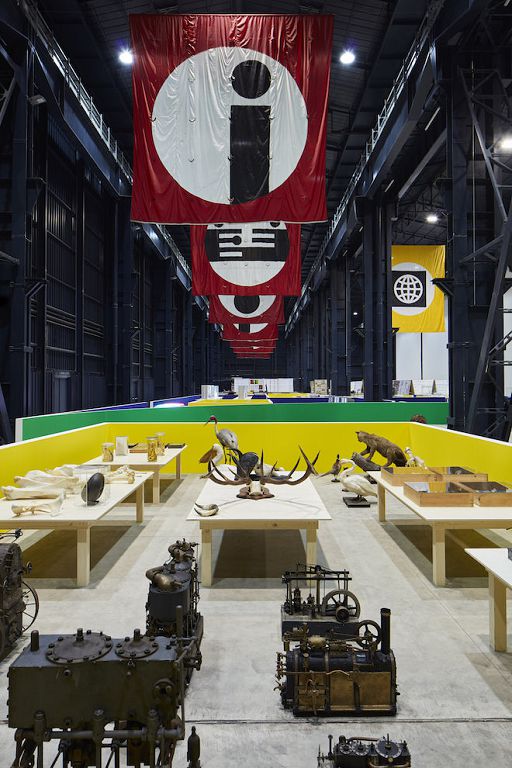
Matt Mullican, “The Feeling of Things”, exhibition view at Pirelli HangarBicocca, Milan, 2018. Courtesy of the artist and Pirelli HangarBicocca, Milan. Photo: Agostino Osio
CM: But did you understand it as a group?
MM: We understood it as a group from the very beginning. There are photographs we took of each other, as a group. We were aware that we were the next generation. There was an awareness that “Our time will come” — just a matter of when. This was in the mid-‘70s. It happened in the ‘80s. Everything changed in 1980. I had no interest in joining a commercial gallery in ‘79 and in ‘80 I had three galleries wanting to represent me: Metro Pictures [which had just been founded by Helene [see note 1LINK], Mary Boone and Anina Nosei [Jean-Michel Basquiat’s first gallerist]. And I went with Mary because everyone was going with Metro and Helene was ‘mom’ — she was my ‘mom’ already and I didn’t want to go with her: I wanted to leave ‘home’.
We didn’t really hang out with other groups; we were our own group. Robert Longo started working at the Kitchen Center LINK http://thekitchen.org [a non-profit art space]. So, we all did shows there. I did performances there — I started working with hypnosis at that time in the ‘70s. And in ‘81 I had my first trip to Europe [as an artist]. With John being our teacher, it was very clear to me that that’s where I wanted to end up. I wanted to be an international artist, so the first chance I got was a group show that [Q. Jamana Shilan???.................................and where??? ] did, which was called “American Inexpressionism” — that’s how he called it, because “Expressionism” and “Neo-Expressionism” was all the rage, so this was an alternative to Neo-expressionism: In-expressionism! And in that show, was everybody: Richard Prince (1949-) to Cindy Sherman, to Jack Goldstein, myself, David Salle — we were all together in that show. I was the only one who actually went to the opening because he could not fly us there but he could put us up. Since I wanted to go to Europe anyway, I went. Having gone, I started getting connected up with the galleries there and within six months I started showing there and it just grew and grew and grew. Then I was in Documenta in ’82 [the first of three times] and that was when we all started showing. Barbara Kruger, whom I’ve known since forever; that whole bunch, from Barbara, to Cindy, back to the mid-‘70s we knew each other, before this all happened.
Rock & Roll was a big deal back in the ‘70s, so a lot of people were in bands — like Robert was in a band with Richard Prince called Menthol Wars. And there were parties where … at the end … there would be Battle of the Bands, everyone had been drinking, and we’d break up into bands and play music — faux music, really; it wasn’t “music” — where David Salle would be playing the vacuum cleaner and Eric Fischl (1948-) would be playing bass and then Barbara Kruger would be on cymbals, and it was like a round-robin sort of thing. So that was the moment. We all knew each other in this way. Ross Bleckner (1949-) was part of the group [too].
MM: I went to Europe on average, in the 1980s, every 2 months. Back and forth.
CM: That was a lot then.
MM: That’s a lot. Maybe even sometimes once a month. My kids were born in 1994. So that changed things a little bit but not hugely, because I would make my trips short. I would come for under a week. That was my rule.
My work within the context of all this and why my work fits in, is in a sense that I wanted to go the opposite of the conceptual artists. We had a problem, my generation: we had to follow Lawrence Weiner and the conceptual artists, the Minimalists, and a bunch of others, and this was a hard thing to do because reductivist, modernist theories had taken art to the point of “the statement” and then art was done. In fact, even someone would talk so the actual object would disappear: it would only exist in time with the viewer — that’s Ian Wilson (1940-). So, what happens after that? What are you going to do? In a sense, I was saying: it’s not the Object at all; that’s the wrong thing: it’s the Subject.
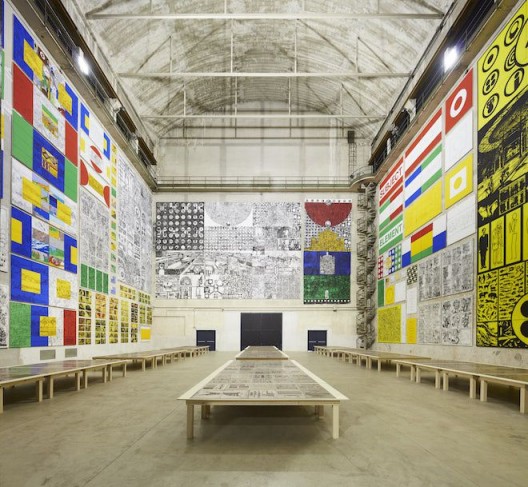
Matt Mullican, “The Feeling of Things”, exhibition view at Pirelli HangarBicocca, Milan, 2018. Courtesy of the artist and Pirelli HangarBicocca, Milan. Photo: Agostino Osio
Glen, or Stick Figures
I wanted to prove, ridiculously, that stick figures live lives. So I drew a stick figure named Glen and I gave him a life; I gave up 500 drawings of Glen in a studio and basically did experiments with his physical reality. I went through his psychology, his biology, his motives, et cetera; his blood, his nerves, his sweat, his tears, his ambitions, his fears: just all in relationship to a person who existed in this space. And I used to call it a “fictional reality” or an “imaginary reality” or “imaginary universe.” In time, it becomes clearly a “virtual” space, although there were no machines representing it.
We leafed through a book with pictures of Glen.
“Glen notices a letter that’s been slipped under his studio door.”
So I have a clock, a calendar, and a plant.
“Glen thinks about the time he hurt himself skiing.”
“Glen falls asleep near the corner of his studio.”
“The sound from next-door drives Glen crazy.”
Then this evolves into this: breathing, smelling his sweat, he is now with his friends, he is terrified, he is delighted.
So, I am going into this person, into this world. I wanted to prove that stick figures live lives. It’s not so much the physical picture that’s the issue, it’s the image in the brain, obviously. I also did a series: pricking his finger — feeling pain. So, if Glen takes a pin and pricks his finger, he feels pain. I’m interested in the pain that he feels. Basically, in today’s world it would be the empathetic response to the picture.
CM: Or lack thereof …
IMAGES AND SIGNS
MM: So, in the meantime, what happens is that there’s this whole thing called mirror neurons. When we see pictures, our body participates with [what’s going on in] the pictures, and the highest level of the neuron being mirrored is in theatre, more than in film, because they’re real people and that is too strong an impulse for us to deny. So, I am very much interested in how meaning is transferred and what we give [as viewer] to the picture, in terms of reality. See, I used the word “picture”. I used it a ton back in the day, early ‘70s, ‘73, I was very interested in breaking down the picture and also signs.
CM: Can we pause a second here? I look at that [a picture of Glen with arrows in his side], and my immediate thought is St. Sebastian. And I’m thinking: in the Renaissance and Baroque, they were using these pictures to engender a physical, an emotional response, that is tied to the psychology, and religion.
MM: Yes, this is what I’m into … [in the mid-‘70s] I made pictures that had the title above and the object symbolized. It was almost like pushing buttons to access information. People would talk about “China”, or “Egypt,” or “Japan,” or “Mayan culture,” or “Peruvian culture,” and refer [to] it not as contemporary life but as a view of what art was. In retrospect, my work is about the emergence of the “iPhone,” the internet, because pictures don’t have to have substance. Pictures exist in their own reality. They are psychological. They are pure. I noticed when you have a sign of something, it is being non-phonetical. It is faster than a word. It’s a different part of the brain. Frank Stella once said that his paintings were like super-fast cars, like you would get it in a second! You would see it; you would get it; you would understand exactly what it is. Now I thought that my flags were faster, faster than a painting. Now, I am not after speed: I am interested in the relationship. But here you have the studio demonstrations: magnets and magnetism, heat absorption, cutting [Glen’s] arm. These are two views of a fictional object. There is this sense of humor: “object under claw” — there is an object and there is not an object. There is a mirror: showing what’s over here, so there is an “over there”. It is a fictional detail, which is a Catch-22.
CM: Because “over here” is off the edge of the paper.
MM: Exactly: it doesn’t exist.
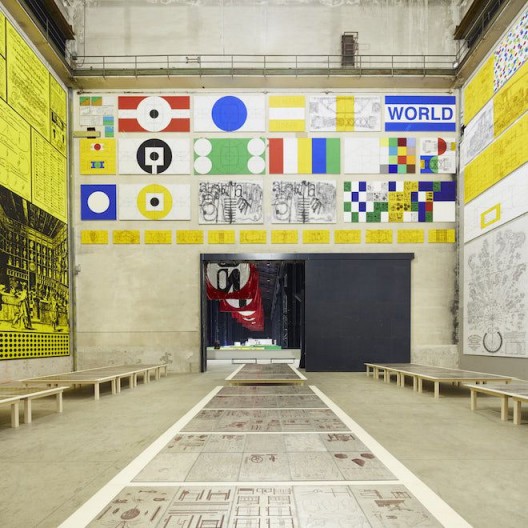
Matt Mullican, “The Feeling of Things”, exhibition view at Pirelli HangarBicocca, Milan, 2018. Courtesy of the artist and Pirelli HangarBicocca, Milan. Photo: Agostino Osio
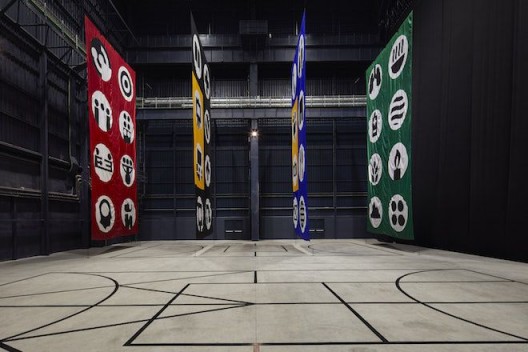
Matt Mullican, “The Feeling of Things”, exhibition view at Pirelli HangarBicocca, Milan, 2018. Courtesy of the artist and Pirelli HangarBicocca, Milan. Photo: Agostino Osio
RELIGION AND HYPNOSIS
We are looking through photos in an old book.
MM: Here for instance, that’s Jim Welling, David Salle and myself with Paul [ … .]. [*IMAGE ?] This is in ‘77. Jim took the picture [remotely] and so he’s looking away, because he’s aware of what he is doing. And here is Paul again — this is at Artists Space. This is me in hypnosis.
This is Paul and myself, where I projected myself into a picture, walked around it, and described to the audience what I was feeling in that picture and what time of day; all the specifics. And then he lit it on fire, and thus it manifested.
CM: How did you react?
MM: I talk about it in my lectures, like in relation to The Twilight Zone or some Sci-Fi movie, like I’m stuck in there forever. The portrait is gone. But it was just heat on my face and then I slid down the hill, because [the drawing] is from a book on Piranesi and it’s a picture of an arch — a very physical object I was participating in: a pictured-object.
So, if I’m talking about the psychological space of the world, immediately I was attracted to religion — because that is kind of like, what we do! — the symbolic representation of the cosmology. When I was a child, I believed I chose my parents. I remember asking my parents at one point, where was I? They said, “You were not born yet.” And I said, “Yes but where was I?” In a child’s mind, you’re always there. In our minds, in fact, we’re always there, we’ll always be. Obviously, birth and death are understood but emotionally we’re always in the present. So, then I had this idea as a child — I must have been 10 or 11 — that I was on a conveyor belt and there was a chute with my father’s name on it and I went down the chute and entered life. I also believed that fate controlled my life, as I lived my life. And Fate looked like he was watching a big TV set and he had a lever that he pulled and in pulling the lever, watching the TV set, he controlled my life. So, it’s very much like a computer. And I’m being controlled by this god figure watching me on TV. Then it gets more complicated as I became much more involved with death and the object. It was primal. I wanted to draw a dead stick figure, a real dead stick figure. I called up the city morgue and they said, “Forget it!” But a friend of mine who was going to medical school at Yale did have a cadaver, so I went and did stuff with the cadaver, which of course related to the stick figure. Death was big, an early subject in my work. It’s a primal subject. So is god. When I was at CalArts and even after, into the ‘’70s, and to today, in this group of people, I’m the only one who addresses god. I am the only one that addresses death. The only one that addresses the world, directly, the sign. And it’s made me a little bit of an outsider with the group.
In ‘73 I was cutting up details of comics and then stating what they were. So, here, collecting dead comic book characters. This really identifies with the pictures: just cutting it up and then making a found object out of the picture itself, which is right in there with all of them. But at the same time, I was doing this religious stuff. So, Fate meets Death at my death, and they decide if I go up to heaven or if I go down to hell. This is a cosmology. And one of the things about that, is that my parents were collectors of what you would call “World Art”, so I grew up with American-Indian [art], Central American Indian, Indian-Indian, Japanese, Chinese, Asmat, [Papua] New Guinea, all that stuff — our house was crammed with all these objects! Crammed! Beautiful Hopi pieces. Innuit. Northwest Coast. After I came back from doing all this [art experimentation], I was in that room [at my parent’s] and looking around and realizing not one object was considered “art” when it was made. They were not decorative. They were something else. Most of it was medicine. And I said, well this is at the core of what art is! …
The cosmology — life and death and birth — was kind of in-your-face, just weird, and I liked that, because it was the only taboo I could come up with at CalArts where anything went, except the only thing no one would even touch, was spirituality. It just didn’t happen. You didn’t talk about angels. You didn’t talk about heaven. You didn’t talk about god. So, I said, “God! No one’s talking about this!” And it’s at the core: this is so important — in the whole history of art, this is it! And yet no one is talking about it! No one is doing anything with it!
There’s this distance. That’s what Jack Goldstein used to talk about, distance from the image. That’s something I am still very aware of. People would ask me, whether I believe in God and I said, “I believe in believing in God but that’s all I’ll tell you;” I will not say, “I believe in God.” I’m more a believer in fate than a believer in God. I don’t know what or who God is but it’s certainly an interesting idea. So, I got in trouble but that’s fine, because it gave me legs and I’m still trying to prove it.
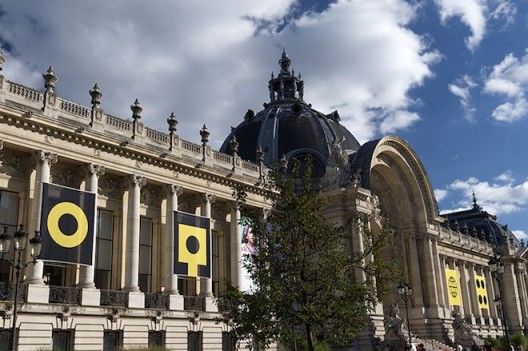
Matt Mullican, “The Feeling of Things”, exhibition view at Pirelli HangarBicocca, Milan, 2018. Courtesy of the artist and Pirelli HangarBicocca, Milan. Photo: Agostino Osio
CM: You picked a tough city in which to do it!
MM: Berlin?
CM: Yeah, they don’t believe in many gods here. They had a bad experience!
MM: — No, no. God is a fiction, a high-level fiction, a fiction that is shaping the world, politically. I mean — God! — it’s at the core of a lot of problems.
CM: The fiction’s not the problem though, is it?
MM: No, but it is when the fiction becomes real. I mean: it is real — fiction is real! This is something I’m interested in. Pictures are real.
SUPERCOMPUTER
In 1986, I started working with a supercomputer back in L.A. I had a big exhibition, and I had a big cityscape, because it was L.A.! And someone wrote, how would you like to go to your city and walk around in it? Cos I had already done this with my mind’s eye — 10 years earlier, in 1973. So I said, absolutely, I’ll do it! It was completed in ‘89. It was a virtual environment, and I became part of that world for a couple of years, where I was going to Iwo Jima and Ars Electronica, and various other venues to do with virtual space. Finally, the French Ministry of Culture came to an opening of mine and they said, “We would like to do a project with you; what would you like to do?” And I said, “I would like to make a virtual environment.” So, we made mine, with the VR glasses, in 1991, where you go into a house, and so forth. So, the city itself is an interface — when you’re here, you see one thing, and when you’re in another, you see something else. So, in a way, the actual architecture [became] the buttons. There’s not one city but five — a fantastic idea — because each section redefines the whole.
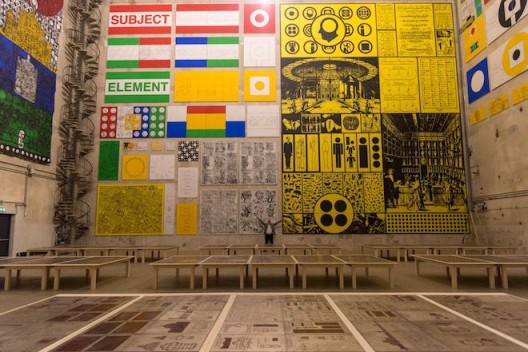
Matt Mullican, “The Feeling of Things”, exhibition view at Pirelli HangarBicocca, Milan, 2018. Courtesy of the artist and Pirelli HangarBicocca, Milan. Photo: Agostino Osio
HYPNOSIS
MM: At the same time as I was doing this, all along I’ve been working with hypnosis. Hypnosis separates this feeling of submersion into the media from the media itself. I cannot watch a Hitchcock film because I get too freaked out, or I don’t like watching splatter films because it makes me sick. If you take away the splatter film, you can [still] get sick, with hypnosis. It does it in another way. And you feel it, very strongly. It is a scary thing.
CM: I’ve never tried it. It’s not a case of being completely unconscious, is it?
MM: Not at all. You are totally aware, when you are doing it: you’re just unaware of the subject. It’s not far from meditation. It’s a level of concentration that you gain which allows you to really experience “The Sign”, be it the word or the image or a suggestion of any kind. And I have been doing that since the first time when I entered the picture in ‘73, which was a form of self-hypnosis. I have worked with many, many hypnotists, I think up to 20. I even did an MRI in a trance state: they wanted to look at my brain. It was an experiment we did in New Castle, in England, because there is a neuroscience center there. I was participating in a group show and they were interested in dealing with this.
CM: I am thinking of Jean-Paul Sartre trying LSD and how he reacted to that.
MM: I did LSD, once, when I was in college. It must have been fairly weak. The closest druggy experience that hypnosis approaches, for me, was mushrooms. In a sense, it’s not so far from that. The fact you could be with one object for hours and there’s this weird sense of humor that occurs. But the hypnosis, in a way, distils the response to the picture from the picture itself. So, if you were to think about representation, if you were to take the bodily response to the picture — I mean, it could be moving pictures; it could be a book; it could be a sign; it could be a cartoon — you are getting close to that participation as a separate entity. That process has had a progression. During hypnosis, I talk about “that person” — and that person, is this individual that I become in the trance state. That individual, you could say, is psychotic. People think of me in that state as being either autistic, psychotic, or schizophrenic; it is an aberrant state of mind, but one that is creative enough to participate in a given action.
Though once, in Australia, I went so deep that the body just became a physical thing, at that stage. These performances are pretty strong and they’re quite embarrassing for the audience to see. People don’t really understand what I’m doing and that’s ok but they get scared — for me. As I get older — because I’ve been doing it for almost 40 years now — I am becoming more vulnerable, so it makes it worse. When I am writhing on the floor, people are scared for me, that I’m going to hurt something. This separation from the armature of the picture is something.
The last performance I did was at Haus der Kunst in Munich. That was a killer.
My work is basically five worlds, those five worlds that exist in this chart.
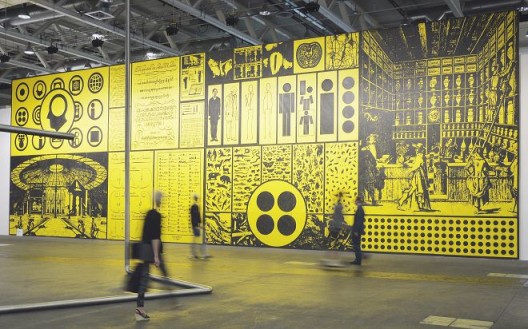
Matt Mullican, “The Feeling of Things”, exhibition view at Pirelli HangarBicocca, Milan, 2018. Courtesy of the artist and Pirelli HangarBicocca, Milan. Photo: Agostino Osio
The Subjective
Green – elemental, the materiality of things
Blue – the world, unframed, the regular outdoors, street, house, wherever we live
Yellow – the arts: the world framed, communication
Black – language
The difference between arts and language lies in their relationship to the world. For instance, what’s the information on the iPhone? It’s not physical. So, when we go into the black area we’re no longer dealing with the physical world. Whereas the Yellow and the Blue have to do with the physicality of the image, whereas in the sign, there is no physicality, it exists as information in the abstract. What conceptual art wanted to be and what Lawrence Weiner really took, he said, you may or may not build the object. So, the information can exist independent of any object. This is a debatable discussion, because the physical object may or may not always exist, we are physical and when we are conceptualizing, it is part of our physical body.
And then the top, I have the Subjective [Red?]: which is to do with the end of that chain. The Subjective is the relationship to the sign, our personal relationship: “Is it good? Is it bad? Is it happy? Is it sad?” In the subjective, I only have that person and the cosmology, but it could be in the sign. There are lots of crossovers. And you could take any object, like my iPhone, and it can apply to every world. So, it’s an interpretative architecture. Thus, things coexist but not in the same place: they coexist in time.
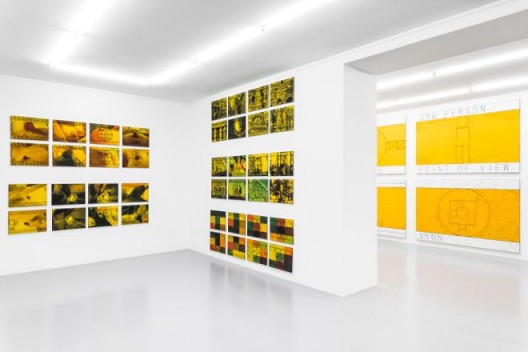
Matt Mullican, “The Feeling of Things”, exhibition making of, 2018. Courtesy of the artist and Pirelli HangarBicocca, Milan. Photo: Francesco Margaroli
BERLIN
What’s happened with me and the Pictures [Generation], is my life as an artist has become very independent of, say, David Salle and Jim Welling. We just had lunch — David had a show uptown — the first time in 35 years. The three of us, we had not sat together since, probably, 1981. Since 1985, I’m my own person and mostly my work is in Europe. When I’m in New York, after a while I get depressed. New York is terrible! And the U.S. is terrible, politically speaking — it’s just tough. So, I am happy to be back in Berlin. I like Berlin. We came here because my wife is a curator and she got a job at Haus der Kulturen der Welt and I got a job teaching as a professor at HFBK in Hamburg [Hochschule für bildende Künste]. I’ve entered my last year there. I’m 66 and next year I will retire.
Pirelli HangarBicocca
In 2018 Matt Mullican will show at the vast Pirelli HangarBicocca. Previous exhibitors there include Anselm Kiefer, Philippe Parreno, Apichatpong Weerasethakul, Tomás Sareceno, Joan Jonas and currently, Lucio Fontana
http://www.hangarbicocca.org/en/exhibition/matt-mullican/#
BALDESSARI
I take what I can get. I’ve been at it for 45 years now — my work … And I’m still chugging along, still trying to do the same things I tried at the very beginning. The work is growing and I’m excited about it. I learnt a lot from Baldessari, I really did. He managed to, somehow, keep himself interested.
CM: He famously burnt all of his [early] work and got rid of it.
MM: Yeah!
CM: And started afresh.
MM: He did, he did! You know, his sister, he said to her, before I burn it all, you take a few things if you want any. And she took a lot more than he thought she would! And it came out! And that work looks so much like the work he’s doing now! It looks just like the work he’s doing now! All his recent shows have the work he was doing before he burned it. It’s fantastic stuff, like billboards. Thanks to his sister! It’s thrilling, fantastic!
[photo of Matt with Baldessari under a tree??]
What do signs do? They’re about memory. They’re about recognition. Flags — what is a flag? The flag functions because it is supposed to represent something from a great distance, and very fast … [photo of flags at Haus der Kunst and Neue Nationalgalerie]
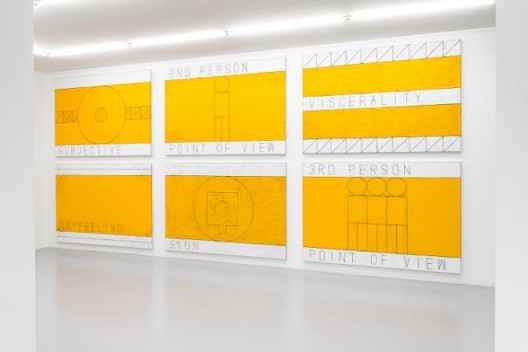
Matt Mullican, “The Feeling of Things”, exhibition making of, 2018. Courtesy of the artist and Pirelli HangarBicocca, Milan. Photo: Francesco Margaroli
INSTAGRAM FOOD. VAGINAS. PENISES.
We walked next door to look at the new work.
I wanted to bring up the images that were from the meaning of things, which were really taken off the internet, which were to do with different ways of seeing that I have been involved with for forever: I mean, for 45 years! And it really comes down to this visceral response to the picture and how people use it. And sex is the most dominant functionality. When online sex is such a big deal. When you have people getting excited at looking at people having sex, from looking at a body. I’m most interested in people looking at people having sex and then getting excited, getting an erection or getting soft or whatever you want to call it. Then also, when you see someone being violated — beat up, tortured, executed — and how you [are] feeling with that, and how terrible that is. So, you have this visceral response to these pictures. Then there are these others, one is having to do with virtual [violence] — I will have a set of “Grand Theft Auto” people that I’m going to be putting in here, and then also public executions, and then also cutting, just the cutting of the skin.
We look at the pictures arranged on the ground of naked bodies, some showing heterosexual penetration, some showing the subjective point of view glimpsed beneath bed covers.
… Here’s more cuts. There you go. And they’re all numbered and lettered, again this kind of obsession with doing many, many, many of one thing: systems! Systems are always part of what I do. I have never shown this work before. This is a show that’s going to open in Zurich at Mai 36. We’ll see how it goes, but it allows me to show all my work and I can go into my books and show signs from the ‘70s in this body of work. They’re all printed in yellow. I print a sheet of yellow [base color] and then I print the color on top of it. The earliest work I have is “Colors Under a Green Light.” So, I had a green light on color-aid cards. So, everything has been changed. And this is very similar [but] it’s the Yellow, and the Yellow in my work is the Art. It’s the psychology of how that separation is represented in the color. Everything is filtered through yellow, the whole show.
There’s a set of 8 in each section. This [set] is horizontal but it could be vertical.
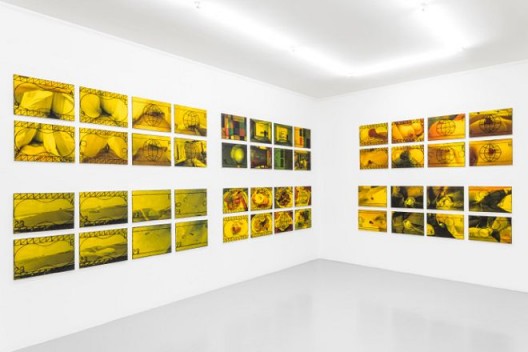
Matt Mullican, “The Feeling of Things”, exhibition making of, 2018. Courtesy of the artist and Pirelli HangarBicocca, Milan. Photo: Francesco Margaroli
CM: What are these images here?
MM: This is a train: the speed of a train. This is velocity. It ends up looking like a Gerhard Richter and what I think he is trying to do is to get to this visceral sense of abstraction and it’s an impossibility, [because] viscerality exists within the brain. The best visceral response exists in a temporal environment, not in an atemporal environment. This is atemporal. It doesn’t exist in time. In an atemporal environment, it doesn’t exist in time; it exists as a still [image]. In an atemporal environment, the visceral element has to come in the reality of what you are looking at, so if it was a painting — how you made the painting disappear because of the super-realism or the trompe l’oeil — that is as close to viscerality, in the painting medium, as you can get. You can have giant phalluses or giant heads being cut off, or expressionism which [attempts] to engage the viewer in the process of painting, but it’s debatable [that it can].
Of course, when we see pictures, we feel something. That is the visceral response. Now I am interested in taking it apart. I am aware that when you look at a fantastic picture by, well, name the famous expressionist, you feel it. When you see a Matisse painting, you go, “Wow!” just because of the color and scale, or Pollock, where it becomes totally abstract. He took abstraction further than anybody. No one has come close to Pollock since, because he was dealing with the feeling. Frank Stella was the next chapter after Pollock, and it becomes objective. A Pollock is subjective. He is taking subjectivity down to its core, and he couldn’t survive! And then it flips, because you cannot sustain it, and it becomes objectivity-based.
When you get right to it, I am very interested in Surrealism and Abstract Expressionism.
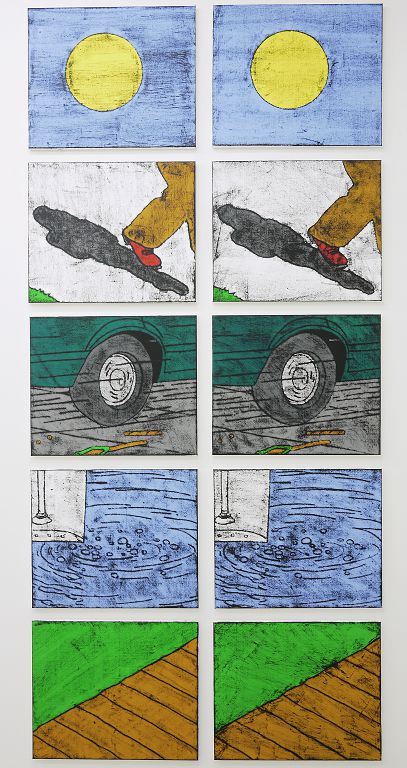
Matt Mullican, “The Feeling of Things”, exhibition making of, 2018. Courtesy of the artist and Pirelli HangarBicocca, Milan. Photo: Francesco Margaroli
THE PICTURES GENERATION SHOW
I’ve been in one show with the Pictures Generation. I’m surprised whenever I’m lumped in with that group but it’s something that’s in my history, because socially speaking I was there. When I talk about what I do, pictures are big part of what I do. There was the show called “Forrest of Signs”, which we were all in, and I was the guy making signs. I was known for doing the sign stuff. “Oh, you’re the guy who makes the signs! You’re the guy who makes the flags.” Before that, I was the guy who made the stick figures, or “You’re the guy who works with computers.” People identify you with different elements. It was nice to be in the show at The Met, the Pictures Generation show. I was the first piece, in that show. When you came in, that was my work. It was a kind of introduction to that whole thing. It was early ‘73.
I worked with Adelina von Fürstenberg [curator]. And she was showing Jack Goldstein’s work very early on and she hooked up into my work. I was in the guest bedroom and there was a work opposite the bed, by Joseph Kosuth, and it was a paragraph describing itself: the paper stock, the ink, the number of adjectives, the number of nouns, the number of sentences — blah, blah, blah — typical of the era. Now, two things: it didn’t say it was an artwork and it didn’t say that it was an artwork made by Joseph Kosuth. He couldn’t, he couldn’t say it. But it was signed, and dated.
CM: Well it’s the same thing then.
MM: But … it’s not the same thing. That’s not the subject: that is the object. The object is signed. The subject is the paragraph. Had he put his name in it, that would have been another story.
CM: But isn’t it interpreted as part of it anyway? I mean, the moment you know it’s Joseph Kosuth, it’s part of it.
MM: He is naming the number of periods! The paper! That [Kosuth] is the most obvious thing! The reason it is in front of you, is because he made it and it is an artwork. And that is the one thing he didn’t mention!
CM: And therefore, you don’t have to —
MM: But it’s at the core! As far as I’m concerned, that’s A-No.1. That’s at the top of the list. And Sherrie knew that as well and that’s what she dealt with. She went with the identity of the art work and the identity of the artist. This is one of the shifts — there are many — that occurred between 1968 and 1973, ‘74. And Joseph, I’m sure, thinks I’ve taken a lot of what I’ve done from him, because there is a distance to what I do. But he is an academic, or he would like to be, with the philosophy. I know nothing of philosophy in the way he does! I’m a primitive in relation to these guys who really know their stuff.
MM: There is a piece by Mel Bochner, which is a piece of wood resting on top of a number of little pieces of wood. It’s called “Levelling”. And I said, why don’t you put a pillow underneath the piece of wood, and then I called it “Sleeping Child”. So it’s taking this Minimalist piece, and by the insertion of a pillow, it becomes figurative, because we associate our heads with the pillow and it becomes us, in a way. The Minimalists were attempting to separate the object from the subject, that the object can exist independently of the subject. It cannot. They are bound. There is no way you can separate them. Although it’s a great ambition, philosophically and formally.
CM: Well, it’s an etymological separation. It’s something we’ve had to invent in order to discuss it.
MM: Yes! I mean, Carl Andre is a great, great, great sculptor. I love his work — beautiful, elegant, great! And that we can walk on it is just wonderful. But it’s an interesting problem. I did this thing where, in my imaginary studio, I took Death’s cape and I burned it and I put it in water and I shredded it up and I hung it from the ceiling. I did things to Death’s cape that Richard Serra would have done to material. They’re attempting to take all references out of the “object” and not only am I putting references back but I’m making an allegorical issue out of it, which is even worse. You know, it’s really the worse thing! But then the allegory still lies separate, on top of it. And THAT is like the hypnosis, it’s that meaning, that soul that we implant into our surroundings. We can’t help it. We just do it all the time. We have done it, to survive.
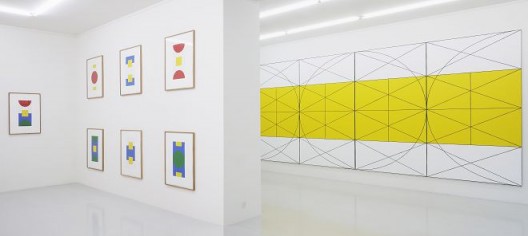
Matt Mullican, “The Feeling of Things”, exhibition making of, 2018. Courtesy of the artist and Pirelli HangarBicocca, Milan. Photo: Francesco Margaroli
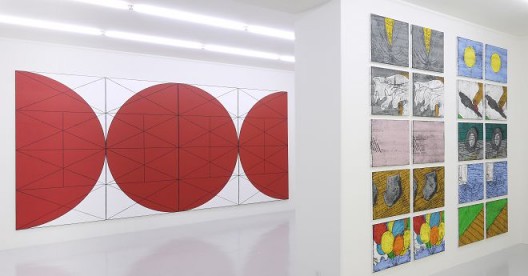
Matt Mullican, “The Feeling of Things”, exhibition making of, 2018. Courtesy of the artist and Pirelli HangarBicocca, Milan. Photo: Francesco Margaroli
NOTES
1. Helene Winer (1946-) is an American curator and gallerist. After studying Art History at University of Southern California, Winer was first an assistant at the Los Angeles County Museum of Art. While travelling in Europe, she became Assistant Director of the non-profit Whitechapel Gallery in London. On returning to Los Angeles, she became Director of the Museum of Art at Pomona College, organizing exhibitions with John Baldessari, John McCracken and Chris Burden, among others. Winer then worked as a writer at the Los Angeles Times before moving to New York, at first working as a freelancer and then, in 1975 taking up the position of Director of the non-profit Artists Space. In 1977, Artists Space held the seminal “Pictures” exhibition, including Troy Brauntuch, Jack Goldstein, Sherrie Levine, and Robert Longo. Curated by Douglas Crimp, and along with Crimp’s influential titular essay in October magazine (Vol.8, Spring, 1979, pp.75-88), “Pictures” was one of the defining exhibitions of the time. After leaving Artists Space, Winer founded Metro Pictures in 1980 with former Leo Castelli director, Janelle Reiring.



